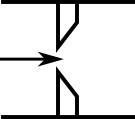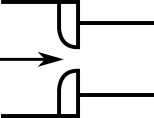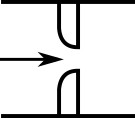Orifice Loss Model
Sharp-Edged Orifice
The orifice loss factors are all for turbulent Reynolds numbers. The sharp-edged orifice shown in Figure 1, is given by the following equation(Idelchik, 2007Idelchik, I. E., Handbook of Hydraulic Resistance, 4th edition, Begell House, Redding, CT, 2007., 259):

Figure 1: Sharp-edged orifice (in this case Aup = Adown)
Round-Edged Orifice with Different Upstream and Downstream Diameters
When the upstream and downstream pipe diameters are different for a round-edged orifice as shown in Figure 2, the round-edged orifice equation for different pipe areas is used and is given by the following (Idelchik, 2007Idelchik, I. E., Handbook of Hydraulic Resistance, 4th edition, Begell House, Redding, CT, 2007., 258)
where

Figure 2: Round-edged orifice with different upstream and downstream pipe areas
Round-Edged Orifice with Identical Upstream and Downstream Diameters
When the upstream and downstream pipe diameters are the same for a round-edged orifice as shown in Figure 3, the round-edged orifice equation for the same pipe areas is used and is given by the following (Idelchik, 2007Idelchik, I. E., Handbook of Hydraulic Resistance, 4th edition, Begell House, Redding, CT, 2007.,262)
where

Figure 3: Round-edged orifice with the same upstream and downstream pipe areas
For other orifice configurations, see Chapter 4 of Idelchik's Handbook of Hydraulic Resistance (2007).
Other Loss Models
Discharge Coefficient Loss Model
When determining the pressure loss across the junction, AFT xStream calculates a subsonic discharge coefficient area (CdA) for the orifice and applies the following set of isentropic compressible flow equations to solve for the static pressure and Mach number at the vena contracta
Where ṁ̇ represents the mass flow rate, To is the stagnation temperature, Po denotes the stagnation pressure, M is the Mach number, γ is the specific heat ratio, R is the gas constant, Z is the gas compressibility factor, and P is the static pressure. Note that the specific gas constant, R, is defined as the universal gas constant divided by the molecular weight of the gas.
For information on the discharge coefficient loss model see the Discharge Coefficient Loss Model topic. For information on the orifice loss when the flow is choked see the Sonic Choking description.



